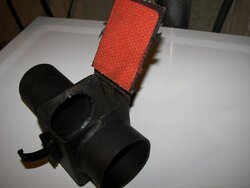Folks,
Today it happened again but because it's friggin' cold I can't fix it just yet. Once or twice per season the P23 clicks itself off after a few seconds. If I start it 2-3 times in a row without letting the combustion blower trundle out too much I can usually get it going. The "fix" is this: I unplug the little hose at the pressure switch, connect some other hose to it, blow through it, push it back on. I guess that moves the soot around a bit where it connects at the smoke path. Unfortunately the connector to the smoke path is at a right angle which isn't a great design. The vent goes up two stories and that doesn't help a fast negative pressure build-up either. But the main problem seems to be that Breckwell set the wait time before time-out too short in the controller, only very few seconds.
Is there a trick to extend that wait time on the controller board? Preferably without writing new software for it
Other question: Did anyone find T-connector and hose that can be used to make a clean-out port? The P23 we have is an insert and getting that hose off usually comes with some contortion and the occasional skin scrapes. And there will be a day when the screws for the front panel wear out their holes if I keep doing this for too many times.
Regards,
Joerg
Today it happened again but because it's friggin' cold I can't fix it just yet. Once or twice per season the P23 clicks itself off after a few seconds. If I start it 2-3 times in a row without letting the combustion blower trundle out too much I can usually get it going. The "fix" is this: I unplug the little hose at the pressure switch, connect some other hose to it, blow through it, push it back on. I guess that moves the soot around a bit where it connects at the smoke path. Unfortunately the connector to the smoke path is at a right angle which isn't a great design. The vent goes up two stories and that doesn't help a fast negative pressure build-up either. But the main problem seems to be that Breckwell set the wait time before time-out too short in the controller, only very few seconds.
Is there a trick to extend that wait time on the controller board? Preferably without writing new software for it

Other question: Did anyone find T-connector and hose that can be used to make a clean-out port? The P23 we have is an insert and getting that hose off usually comes with some contortion and the occasional skin scrapes. And there will be a day when the screws for the front panel wear out their holes if I keep doing this for too many times.
Regards,
Joerg


